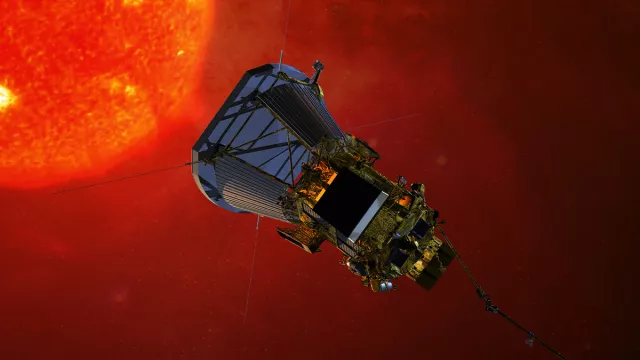The U.S. Parker Solar Probe launched on 12 August 2018 is the first spacecraft to venture into our star’s outer atmosphere.
Key information
Key figures
- 685 kg: spacecraft mass
- 4 instruments
- 7 gravity assists from Venus
- 6 contributing French laboratories
Key milestones
- 2023 to 2025: Closest flybys of the Sun
- 2018 to 2023: 7 gravity assists from Venus
- 12 August 2018: Parker Solar Probe launched by Delta IV Heavy
- May 2017: Mission renamed Parker Solar Probe
- 2014: Phase C/D of development
- 2008: Project refined, funded and renamed Solar Probe Plus
- 2004: Solar Probe project kicks off
Project in brief
Lofted into space by a Delta IV Heavy launcher, Parker Solar Probe received seven gravity assists from Venus to reach the Sun’s corona. These successive gravitational boosts make it the fastest spacecraft of all time. It is also the first to study the solar wind in situ with its four suites of instruments (the solar wind is the stream of ions and electrons that our star ejects at high speed into interplanetary space). Parker Solar Probe plans to pass several times within less than seven million kilometres of the Sun’s surface, exposing it to temperatures of 1,400°C.
One of Parker Solar Probe’s main objectives is to characterize the different types of waves in the solar wind, between the spacecraft’s perihelion (9.86 solar radii) and aphelion (55 solar radii). The nature of these waves and the dynamics of the solar wind are the keys to understanding how it is heated and accelerated. Other science goals include determining the nature of the sources—intermittent or otherwise—of the solar wind and the impact of wave activity on particle transport.
Fluctuations in the Sun’s magnetic field are being measured by the spacecraft’s SCM instrument (Search-Coil Magnetometer) designed and operated by the LPC2E environmental and space physics and chemistry laboratory. SCM is the only French—and indeed international—instrument on Parker Solar Probe.
CNES’s role
French research laboratories—the LPC2E environmental and space physics and chemistry laboratory, the LESIA space and astrophysics instrumentation research laboratory, the IRAP astrophysics and planetology research institute, the LPP plasma physics laboratory and the LAM astrophysics laboratory in Marseille—contributed to Parker Solar Probe’s instruments, with support from CNES. The PROMES processes, materials and solar energy laboratory, which operates the solar furnace in Odeillo in the French Pyrenees, also worked on the mission, studying the behaviour at high temperatures of the parts of the science instruments not protected by the probe’s solar shield.
Contacts
Sun, Heliosphere & Magnetospheres (SHM) subject matter expert
Kader Amsif
E-mail: kader.amsif at cnes.fr


